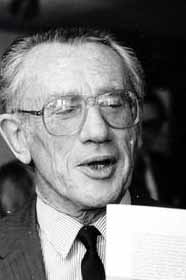![]() Alan Renouf (1919 -
2008) was
perhaps best known publicly as the
secretary of the Department of Foreign
Affairs and the Australian ambassador to
Washington, but he was also a scholar,
soldier, lawyer, author, sportsman and
bridge player.
Alan Renouf (1919 -
2008) was
perhaps best known publicly as the
secretary of the Department of Foreign
Affairs and the Australian ambassador to
Washington, but he was also a scholar,
soldier, lawyer, author, sportsman and
bridge player.
Throughout his distinguished international career, Renouf was realistic enough to accept the limits on Australia's ability to influence world events but patriotic enough to want to maximize that influence.
He was forthright and had a very Australian style, which was not always the case for Australians of his generation. He had his admirers and detractors, but nobody ever accused him of being boring.
He was always his own man and would stand up to politicians he worked for when he felt it necessary. This occasionally got him into trouble with those who did not like being questioned. He admired H.V. Evatt and Paul Hasluck, and some colleagues believe these were the only two he had unstinting admiration for. Evatt was clearly a strong intellectual influence on the young Renouf.
Renouf was not the stereotype of the retiring public servant but was, in his way, more of a public intellectual who liked to stimulate debate and encourage younger officers to come up with ideas. He opened up the Department of Foreign Affairs to women, both officers and spouses, in a way that had not been done before. His style was stimulating and decisive. While leaning towards the Labor Party, he served both sides of politics with equal professionalism.
Renouf was the first of the old diplomatic cadets to become department secretary. He saw active service in New Guinea and learned of his acceptance as a cadet while recovering in hospital from a sniper wound. In typical style, he is reported to have indicated in colorful language that this looked like a much better deal than where he had just come from.
Alan Philip Renouf was born in Sydney, the son of P.N. Renouf and his wife, Elsie Stevens. He went to Sydney Boys High School and Sydney University, where he completed two law degrees and later a PhD in political history. He served with the Australian Imperial Force from 1939-42 and joined the then Department of External Affairs in 1942.
From 1945 to 1949 he was involved in the birth of the United Nations - first on its preparatory commission, then as a member of the Australian delegation to the UN and then as legal counselor in the UN Secretariat.
In 1948 he married Emilia Mira Campins in Buenos Aires, and in 1949 resumed his diplomatic career in Canberra. Renouf served in Cairo, Washington, Paris and Brussels before becoming high commissioner to Nigeria and later minister at the Australian embassy in Washington.

